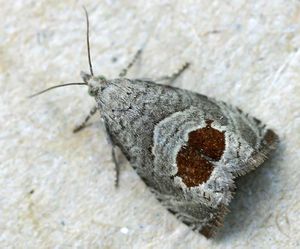Heteroneura
| Heteroneura | ||||||||||||
|---|---|---|---|---|---|---|---|---|---|---|---|---|

|
||||||||||||
| Systematics | ||||||||||||
|
||||||||||||
| Scientific name | ||||||||||||
| Heteroneura | ||||||||||||
| Tillyard , 1918 |
Heteroneura is a taxon of the butterflies (Lepidoptera) from the suborder Glossata . It comprises more than 99% of all known butterfly species and is the sister taxon of Exoporia .
features
The monophyly is based on the following autapomorphies : the wing veins Sc and R of the hind wings are already fused shortly after the wing base, the vein Rs is undivided. The males have a "connected" frenulum composed of several bristles . The jugum of the forewings has receded and only shows something beyond the wing outline. The dorsal arm of the tentorium is severely regressed in the adults . The back of the prothorax carries the central sclerotization behind the paired “main warts” and the bridge between the hips ( coxes ) of the front legs is formed. The mesosternum has a transverse furrow ("mesoclidium") delimited by the seam, which is fused with the prospine . Two separate anterior introductions are formed for the mesofurco-metafurca muscles. The arm of the metaprescutum and the first sternum on the abdomen are hidden.
The embryonic development shows the "fault-type" formation of the amnion and serosa . The cotyledon is immersed in the egg yolk and a temporary epithelial-like membrane, which is formed by the outer yolk cores / vitellophages , is missing.
According to Kristensen (2003), the above autapomorphies justify the monophyly of the taxon, although the females of Exoporia and Ditrysia have similar genital structures. However, these seem to have developed through convergence . The lack of abdominal legs provided with muscles and hook wreaths in the caterpillars of the Nepticuloidea is justified with a presumed further development due to the endophagic way of life.
Systematics
The relationships within the heteroneura have not yet been fully explored and there are currently several different approaches. It is also unclear whether the Ditrysia and the remaining superfamilies form sister groups as Monotrysia . Molecular genetic studies at least suggest that the Ditrysia including the Tischerioidea form a monophylum . For this reason, the subtaxa of the heteroneura are only listed:
- Superfamily Nepticuloidea
- Superfamily Incurvarioidea
- Superfamily Palaephatoidea
- Superfamily Tischerioidea
- Superfamily Simaethistoidea
- remaining superfamilies: Ditrysia
Molecular phylogenetic study (March 2013)
A large-scale study published in March 2013 examined the order of butterflies for kinship relationships.
The cladogram regarding heteroneura is as follows:
| Heteroneura |
|
||||||||||||||||||||||||||||||||||||
|
|
supporting documents
Individual evidence
- ↑ a b c Niels P. Kristensen: Lepidoptera, moths and butterflies . In: Maximilian Fischer (Ed.): Handbook of Zoology . 1st edition. tape 4 - Arthropoda: Insecta , volume 35. de Gruyter, Berlin / New York 1998, ISBN 3-11-015704-7 (English).
- ↑ Jerome C. Regier, Charles Mitter a. a .: A Large-Scale, Higher-Level, Molecular Phylogenetic Study of the Insect Order Lepidoptera (Moths and Butterflies). In: PLoS ONE. 8, 2013, p. E58568, doi : 10.1371 / journal.pone.0058568 .
literature
- Niels P. Kristensen: Lepidoptera, moths and butterflies . In: Maximilian Fischer (Ed.): Handbook of Zoology . 1st edition. tape 4 - Arthropoda: Insecta , volume 35. de Gruyter, Berlin / New York 1998, ISBN 3-11-015704-7 (English).